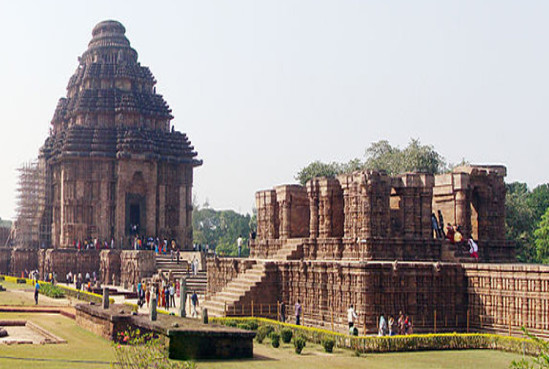
Udayagiri and Khandagiri Caves, formerly called Katak Caves or Cuttack caves, are partly natural and partly artificial caves of archaeological, historical and religious importance near the city of Bhubaneswar in Odisha, India. The caves are situated on two adjacent hills, Udayagiri and Khandagiri, mentioned as Kumari Parvat in the Hathigumpha inscription. They have a number of finely and ornately carved caves built during 2nd century BCE. It is believed that most of these caves were carved out as residential blocks for Jain monks during the reign of King Kharavela. Udayagiri means "Sunrise Hill" and has 18 caves while Khandagiri has 15 caves.
The caves of Udayagiri and Khandagiri, called lena in the inscriptions, were dug out mostly during the reign of Kharavela for the abode of Jaina ascetics. The most important of this group is Ranigumpha in Udayagiri which is a double storeyed monastery. Other important caves include Hathi gumpha, Ananta gumpha, Ganesha gumpha, Jaya Vijaya gumpha, Mancapuri gumpha, Bagh gumpha and Sarpa gumpha.
B. M. Barua, based on a reading of line 14 of the Hathigumpha inscription, declared that a total of 117 caves were excavated by Kharavela and others on the Kumari hill (Udayagiri). Marshall has counted more than 35 caves in both the hills, while M.M. Ganguli has enumerated only 27 caves.
The number of existing caves at Udayagiri is 18, while Khandagiri has 15. The local names of the existing caves are listed below, numbered according to the enumeration of the Archaeological Survey of India.
Rani Gumpha is the largest and most popular cave among the caves of Udayagiri and Khandagiri. The word 'Rani' means Queen. Although it is not an architectural marvel, it has some ancient beautiful sculptures.
This cave is double storied. Each storey has three wings and the central wing is bigger among all the three wings. The lower floor has seven entrances in the middle wing whereas the upper floor has nine columns. The upper portion of the central wing has relief images depicting the victory march of a king. Many of the cells have carved dwara pala images; some of them are disfigured. The area that connects the central wing with right and left wings have some panels where the sculptures of wild animals, fruit laden trees, human figures, women playing musical instruments, monkeys and playful elephants are found. The pilasters contain the toranas (arches) decorated with sculptures of Jain religious importance and royal scenes.

Konark Sun Temple, the 13th century common era Sun temple is a silent witness of the…
view more